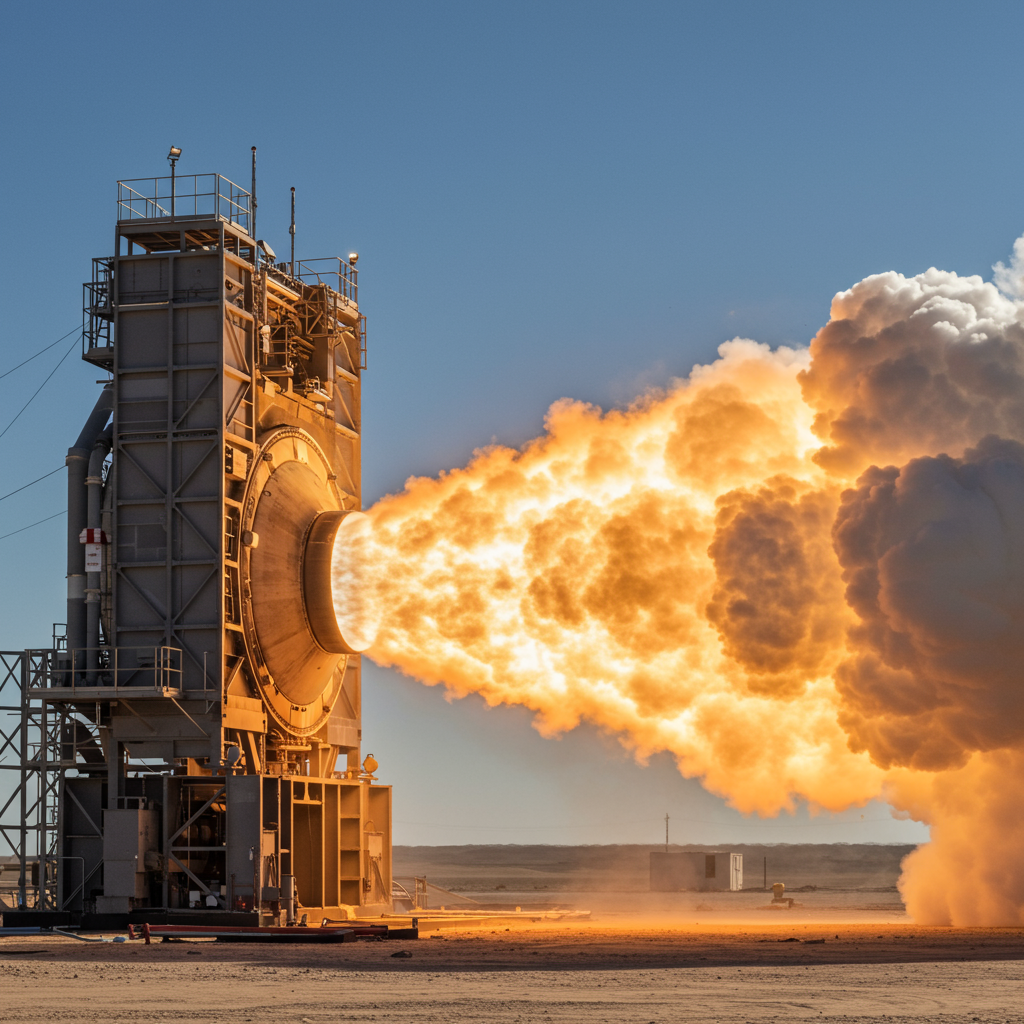In a pivotal moment for American space exploration, Northrop Grumman recently conducted a full-scale static fire test of NASA’s next-generation <a href="https://news.quantosei.com/2025/06/28/utahns-build-test-largest-nasa-rocket-ever-produced-in-promontory/” title=”Utah Tests NASA's Powerful Rocket Motor for Artemis”>booster Obsolescence and Life Extension (BOLE) solid rocket motor. This significant event, held on June 26, 2025, in Promontory, Utah, marked the first full demonstration of a design slated to become the backbone of future heavy-lift launches. Hailed as the world’s largest and most powerful segmented solid rocket motor developed for human spaceflight, the test aimed to validate its cutting-edge design and immense power. While the ground-shaking ignition delivered on its promise of raw force, the test also revealed an unexpected challenge near the conclusion of the burn, providing critical data for the path forward.
Igniting the World’s Most Powerful Segmented Motor
The sheer scale of the BOLE solid rocket motor is staggering. Measuring an impressive 156 feet in length, this colossal booster is designed to provide the initial thrust needed to lift massive payloads into orbit. During the static fire test in Utah, the motor roared to life, generating a tremendous force exceeding 4 million pounds of thrust. For just over two minutes, the booster burned its massive propellant load, creating a spectacular light show and demonstrating the immense power necessary for deep space missions. Engineers monitored the test meticulously, collecting data from over 700 different channels to assess the motor’s performance under extreme operational conditions. This initial phase of the test successfully showcased the booster’s capability to deliver unprecedented levels of power for future space launches.
An Unexpected Turn During the Burn
Despite the powerful start, the test experienced an anomaly towards the very end of the two-plus minute burn. As the motor neared depletion, an unusually bright plume was observed, followed by signs of a potential issue near the nozzle, leading to a fireball and flying debris. While reports suggest a possible faulty nozzle “liberated energetically” about 10 seconds before the planned burn conclusion, officials emphasized the overall success in gathering valuable data.
Jim Kalberer, Northrop Grumman’s vice president of propulsion systems, noted that the test successfully “pushed the boundaries of large solid rocket motor design.” He acknowledged the anomaly but stressed that, as the first test of a new, record-sized booster, it yielded crucial information needed to refine the design for future development. NASA’s SLS Booster Program Manager, Dave Reynolds, echoed this sentiment, highlighting the preference for discovering and addressing such issues during controlled ground tests rather than in space. He explained that they approached the test fully aware they were “pushing the limits on some materials,” making the anomaly a significant learning opportunity.
Introducing the BOLE Booster: NASA’s Next-Gen Powerhouse
The Booster Obsolescence and Life Extension (BOLE) program is not just about increasing power; it’s a strategic move to address critical needs for NASA’s future missions. The current solid rocket boosters used on the Space Launch System (SLS) rocket are based on Space Shuttle-era technology. While proven, these components are projected to become obsolete, with their viability estimated to last only through the Artemis 8 mission.
Awarded in 2017, the BOLE development contract tasked Northrop Grumman with creating a successor. The BOLE booster is intended to replace these aging components, supporting SLS launches starting potentially with Artemis 9, currently envisioned for 2034. Beyond lunar missions, the BOLE’s design incorporates advanced capabilities specifically engineered to support demanding exploration trajectories, including potential future missions to Mars. Its unique “thrust trace grain design” is cited as enabling such ambitious deep space journeys, positioning BOLE as a key component for NASA’s long-term exploration goals.
Design Innovations Driving Performance
The BOLE booster represents a significant technological leap from its predecessors. A key enhancement is the transition to a new carbon-fiber composite case. This composite material is designed to be both lighter and stronger than the steel cases used in previous booster designs. This change not only contributes to improved performance but also facilitates faster manufacturing times.
Furthermore, the BOLE incorporates an updated propellant formulation and advanced components, including plans for an electronic thrust vector control steering system to replace the current hydraulic one. These design modifications collectively contribute to a projected performance increase of more than 10 percent compared to the current five-segment SLS booster design. This boost in power is anticipated to add an extra five metric tons of payload capacity to lunar orbit, a critical factor for carrying larger or more complex equipment on deep space missions. The program also focuses on integrating commonality in design and construction standards from across Northrop Grumman’s production programs, fostering more sustainable commercial practices and reinforcing a U.S.-based supply chain for critical components.
A Legacy of Propulsion: Northrop Grumman’s Role
Northrop Grumman boasts a deep history rooted in providing critical propulsion systems for NASA’s most iconic human spaceflight programs. The company supplied the rocket power for the historic Apollo missions that landed humans on the moon, as well as the Space Shuttle program that operated for three decades. Building directly on this heritage, Northrop Grumman developed the current five-segment SLS solid rocket booster based on the flight-proven design of the space shuttle boosters.
This predecessor to the BOLE booster is already a powerful evolution, generating 25 percent more thrust than its space shuttle counterpart. It played a crucial role in the success of the Artemis I mission on November 16, 2022, providing over 75 percent of the SLS rocket’s initial liftoff thrust. The ongoing development of the BOLE booster in Promontory, Utah, continues this legacy, pushing the boundaries of solid rocket technology to meet the even greater demands of future Artemis missions and beyond.
The Broader Context: Uncertainty Surrounding SLS
While the BOLE booster test represents technological progress, its future application is closely tied to the fate of the Space Launch System program itself. The SLS rocket, while powerful, has faced significant scrutiny, primarily due to escalating costs. The project has reportedly exceeded its initial budget by $6 billion, with the projected cost of each individual SLS rocket substantially higher than initially planned. Some estimates place the overall cost of a single Artemis launch using SLS at over $4 billion.
Adding to this financial pressure, the U.S. administration’s budget proposal for 2026 has suggested a potential phase-out of the SLS and its associated Orion capsule in favor of transitioning to commercial launch alternatives for future missions. Although the SLS program has not been officially canceled, these discussions introduce a degree of uncertainty regarding its long-term viability and, consequently, whether the newly developed BOLE boosters will ultimately see extensive flight use for lunar missions as originally intended. Despite this uncertainty, NASA and contractors like Northrop Grumman continue testing new components like BOLE and updated RS-25 engines, demonstrating a commitment to development regardless of the final program structure.
What’s Next for BOLE Development?
The static fire test in Utah, despite the anomaly, is a critical step in the BOLE development process. Gathering data from a full-scale test, especially when pushing the limits of materials and design, is invaluable. Northrop Grumman and NASA engineers are now analyzing the extensive data collected during the test, paying close attention to the performance characteristics and the specifics of the anomaly.
The BOLE program is designed with iterative testing in mind. Officials have indicated that four additional static fire tests are planned to further refine and validate the booster design. Lessons learned from this initial test, particularly concerning the nozzle issue, will directly inform modifications and improvements to be incorporated into future test articles. This rigorous testing approach aims to ensure the reliability and safety of the BOLE booster before it can be certified for potential use on future human spaceflight missions, provided the SLS program continues its trajectory.
Frequently Asked Questions
What is the BOLE booster and why is it important for NASA?
The Booster Obsolescence and Life Extension (BOLE) is NASA’s next-generation segmented solid rocket motor, developed by Northrop Grumman in Promontory, Utah. It’s important because it’s designed to replace the aging Space Shuttle-era boosters currently used on the Space Launch System (SLS) rocket. The BOLE is intended for use starting with Artemis 9 and is crucial for providing the initial thrust needed for future NASA deep space missions to the Moon and potentially Mars, carrying larger payloads.
How is the BOLE booster different from previous rockets and what power did it demonstrate?
The BOLE booster features several key technical upgrades over its predecessors. It utilizes a new carbon-fiber composite case for increased strength and lighter weight, an updated propellant formula, and potentially an electronic steering system. These enhancements are designed to provide over 10 percent more thrust and add five metric tons of payload capacity compared to the current SLS booster. During its recent static fire test in Utah, the 156-foot-long motor demonstrated its immense power by generating more than 4 million pounds of thrust for over two minutes.
Where did the BOLE booster test take place, and what does the anomaly mean for its future?
The full-scale static fire test of the BOLE booster occurred on June 26, 2025, in Promontory, Utah, a key location for Northrop Grumman’s rocket manufacturing and testing operations. While the test showed the booster’s immense power, an anomaly, possibly a nozzle issue, occurred near the end of the burn. Although this requires design iteration, officials view the test as largely successful because it provided critical data, especially when pushing design limits. This data is essential for refining the booster’s design in planned future tests before it can potentially be used for missions, contingent on the long-term future of the SLS program.
Conclusion
The static fire test of NASA’s BOLE solid rocket booster in Promontory, Utah, represents a significant step in the ongoing development of next-generation propulsion systems for human spaceflight. Northrop Grumman’s latest creation lived up to its billing as the most powerful segmented solid rocket motor ever built, demonstrating over 4 million pounds of thrust during the two-plus minute test. While an anomaly near the test’s end highlights the challenges inherent in pushing the boundaries of rocket design, it also underscores the critical importance of ground testing to identify and solve potential issues before flight.
The BOLE booster, with its advanced composite case and enhanced performance capabilities, is poised to play a vital role in NASA’s Artemis program, assuming the Space Launch System continues its trajectory for deep space exploration, including planned missions to the Moon and potentially Mars. The data gathered from this test will be instrumental in refining the design for subsequent tests and ultimately ensuring the reliability of this powerful new motor. As development continues in Utah, the aerospace industry watches closely, aware that while the path to next-generation spaceflight is complex and faces both technical hurdles and programmatic uncertainties, tests like this are fundamental to expanding humanity’s reach into the cosmos.
Word Count Check: 1178




